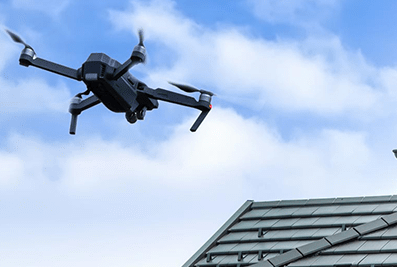
In the world of roofing, inspections and maintenance are vital tasks that ensure the longevity and structural integrity of a building's topmost layer. Traditionally, these tasks have required roofers to scale rooftops, sometimes putting their safety at risk. However, advancements in technology, particularly the use of drones, have revolutionized the way roof inspections and maintenance are conducted. Note that only an expert roofer can make use of the drone for inspection purposes. In this article, we'll explore the significant role that drones play in modern roof inspections and maintenance.
Safety is paramount in the roofing industry, and using drones for inspections and maintenance can significantly reduce the risks associated with working at heights. Roofers no longer need to climb ladders or access potentially hazardous areas. Drones provide a safe and efficient alternative for inspecting roofs, especially in challenging or dangerous environments.
Drones can complete roof inspections and maintenance tasks quickly and efficiently. They can cover large areas in a relatively short amount of time, allowing roofers to identify issues promptly. This speed is particularly valuable when assessing storm damage or performing routine maintenance.
Drones provide comprehensive aerial views of roofs, enabling roofers to examine the entire surface in detail. This perspective allows for a more thorough inspection, as it can reveal issues that may be missed during ground-based inspections. Drones capture high-resolution images and videos that can be reviewed later for a closer examination of specific areas.
Some parts of a roof may be difficult to access, such as steep slopes or areas obstructed by equipment or structures. Drones can access these hard-to-reach areas with ease, ensuring that no section of the roof is left uninspected.
Roof inspections and maintenance conducted using drones can be more cost-effective than traditional methods. It eliminates the need for expensive equipment like scaffolding or lift trucks, as well as the labor costs associated with manually climbing and inspecting roofs.
Drones equipped with advanced sensors can provide real-time data and analysis during inspections. This means that as the drone flies over the roof, it can detect and report issues such as moisture infiltration, temperature variations, or damaged shingles. This immediate feedback allows for on-the-spot decisions and quicker problem resolution.
Drones can generate detailed reports with visual evidence of the roof's condition. These reports can include annotated images and videos, making it easier for clients and roofing professionals to understand the extent of any issues. This documentation is valuable for insurance claims and future maintenance planning.
In conclusion, drones have transformed the field of roof inspections and maintenance. As the technology continues to evolve, we can expect even more innovative applications in the roofing industry, further improving the quality and effectiveness of roof inspections and maintenance.
Consult with our team of experts at 1274 5th Ave New York, NY 10029 (212) 457-1324 https://bestroofingnyc.com